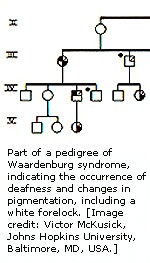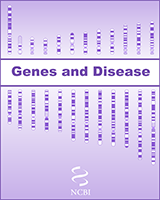NCBI Bookshelf. A service of the National Library of Medicine, National Institutes of Health.
National Center for Biotechnology Information (US). Genes and Disease [Internet]. Bethesda (MD): National Center for Biotechnology Information (US); 1998-.

The main characteristics of Waardenburg syndrome (WS) include: a wide bridge of the nose; pigmentary disturbances such as two different colored eyes, white forelock and eyelashes and premature graying of the hair; and some degree of cochlear deafness. The disease was named for Petrus Johannes Waardenburg, a Dutch ophthalmologist (1886-1979) who was the first to notice that people with two different colored eyes frequently had hearing problems.
The several types of WS are inherited in dominant fashion, so researchers typically see families with several generations who have inherited one or more of the features. Type I of the disorder is characterized by displacement of the fold of the eyelid, while Type II does not include this feature, but instead has a higher frequency of deafness.
The discovery of the human gene that causes Type I WS came about after scientists speculated that the gene that causes 'splotch mice' (mice with a splotchy coat coloring) might be the same gene that causes WS in humans. They located the human gene to chromosome 2 and found it was the same as mouse Pax3. Pax3 is one of a family of eight mouse Pax genes that are involved in regulating embryonic development at the level of transcription.
With a mouse model to draw from, scientists are learning much about how Pax3 causes Waardenburg syndrome.
Related diseases
- Genome view see gene locations
- Entrez Gene collection of gene-related information
- BLink related sequences in different organisms
- Research articles online full text
- Books online books section
- OMIM catalog of human genes and disorders
- GeneReviews a medical genetics resource
- Health information from the National Institute on Deafness and Other Communication Disorders, NIH
- OMIMRelated OMIM records
- Waardenburg syndrome - Genes and DiseaseWaardenburg syndrome - Genes and Disease
Your browsing activity is empty.
Activity recording is turned off.
See more...
